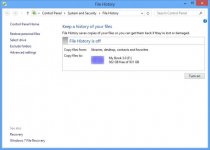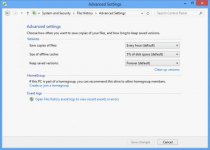David Baxter PhD
Late Founder
Automatically Make Continuous Backups of Personal Files with Windows 8/8.1 File History
by V. Laurie, TechSupportAlert
February 5, 2014
If backing up your files always seems like the chore you never get around to and you have Windows 8.x, you will welcome a new feature called ?File History?. It makes it very easy to set up frequent and automatic backups of your personal files and data. However, it is disabled by default. Here?s how to enable it.

There are several ways to access File History. Here is one that works from either the Desktop or the Start screen:
You can also use Control Panel-> System and Security -> File History to open File History.

The default setting is for hourly backups but this and other settings can be configured by clicking ?Advanced settings? on the left side of the File History window. Click the second thumbnail to see an example of an advanced settings dialog window.
File History only backs up files stored in libraries, desktop, favorites and contacts folders. It does not replace a complete system backup. However, it provides a very convenient way to protect personal files. It is very fast and uses few system resources. Some details of how it works are given in an article at Microsoft TechNet Magazine.
More detail about using File History can be found in this article.
by V. Laurie, TechSupportAlert
February 5, 2014
If backing up your files always seems like the chore you never get around to and you have Windows 8.x, you will welcome a new feature called ?File History?. It makes it very easy to set up frequent and automatic backups of your personal files and data. However, it is disabled by default. Here?s how to enable it.

There are several ways to access File History. Here is one that works from either the Desktop or the Start screen:
- Use the keyboard shortcut Winkey+W to open the Settings search function.
- Type ?file history? or just ?file?.
- Click ?File History? in the list of selections that opens (not "File History settings").
- The File History dialog window will open. Click the first thumbnail to see an example.
- You can choose to have backups placed on an external disk like a USB drive. Attached drives will be automatically detected or you can click ?Select a drive? from the entries in the left side of the File History window.
- Click ?Turn on? once you have selected a drive.
You can also use Control Panel-> System and Security -> File History to open File History.

The default setting is for hourly backups but this and other settings can be configured by clicking ?Advanced settings? on the left side of the File History window. Click the second thumbnail to see an example of an advanced settings dialog window.
File History only backs up files stored in libraries, desktop, favorites and contacts folders. It does not replace a complete system backup. However, it provides a very convenient way to protect personal files. It is very fast and uses few system resources. Some details of how it works are given in an article at Microsoft TechNet Magazine.
More detail about using File History can be found in this article.
